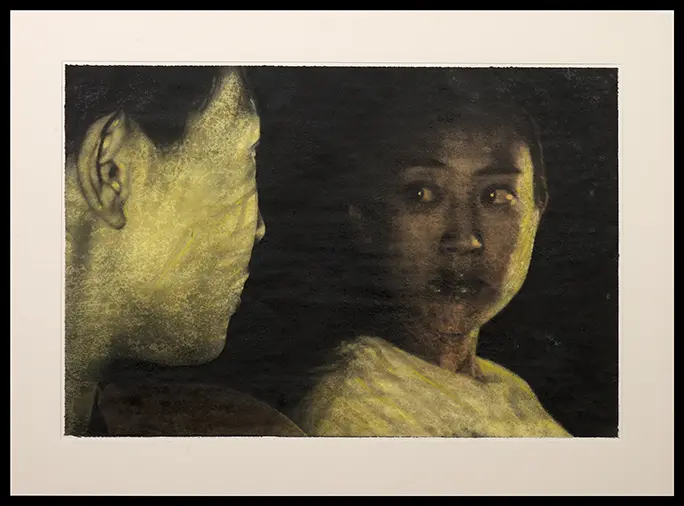
Perspective through portraits: A visit to Nickle Galleries
By Ilana van der Merwe, September 15 2023—
The Nickle Galleries — A local gem located within the Taylor Family Digital Library that often goes overlooked by students — host a variety of uniquely curated exhibits that feature Canadian artists. On the surface, art is displayed on campus to enrich the environment of the University. However, as a first-year student, I have found that the exhibit “People We Know: Portraits from the Collections of Nickle Galleries” presents lessons on perspective that I plan to utilize as I approach my time at the University of Calgary.
From the faces of coins to the walls of parliament or your typical family refrigerator, portraits have been admired for centuries. Marina Fischer, the curator of this exhibit, purposefully placed her definition of a portrait directly in front of the entrance of the gallery; printed simply in ink on cardstock. The poster read: “A portrait is typically defined as a representation of a specific individual; yet, it does not merely record someone’s features but says something about their character and personality offering a vivid sense of a real person’s presence”.
As you walk into the gallery you are greeted by a vast hall of faces, each presented accordingly to tell their own stories. With closer inspection, you can identify shared symbols between the pieces that directly tie into the art’s message.
Maxwell Bates’ watercolour painting was conveniently hung across from Michel Williatte’s sculpture. The juxtaposition of their mediums accompanied by their vastly different colour pallets highlighted their one shared feature: a cage.
Bates’ painting “Theseus” encapsulates the portrait of an older woman, grinning from ear to ear. Within her hands, she proudly holds a cage, containing three balloon-like hearts, cartoonishly painted to complement the simplicity of her demeanour. She is warm, the painting is inviting and the work leaves you feeling hopeful. Turn 180 degrees and one finds Williotte’s “Self Portrait”, a sculpture of a man, sitting placidly within a blunt wooden cage. He sports an expression that can only be described as mild agitation. The piece is haunting and even its position within the exhibit itself seems isolating. This sculpture is disconcerting but clearly succeeds in executing its intended emotional response.
The cages in these two portraits offer an important lesson: The key to creating optimal outcomes is a positive outlook. The personalities preserved in both of these pieces were presented with similar conditions. The artists’ interpretations of the shared symbol of a cage prove that perspective is key to success.
Throughout orientation week, the advice of envisioning the bigger picture was repeated by advisors like a mantra. I only intended to apply this to the ways in which I selected courses or made academic choices, but this exhibit in the Nickle Galleries allowed me to think more open-mindedly.
For pieces like the ones created by Greg Payce and Chris Cran, the true meaning of the art does not present itself until the viewer takes a step back. To further understand the artist’s intention one must view the piece as a whole.
Cran’s work, “Mirror”, seems to be nothing more than a framed collection of ‘bar-code-esc’ stripes. From up close the piece seems abstract and confounding. However, if the viewer removes themself from the direct line of the painting, the image becomes clearer. The painting depicts the silhouette of a woman. If one steps back even further, words like “free” in the style of comic book illustrations can be seen.
Payce’s work “Albedo” is described within the exhibit as “36 vases, [the] negative space between [vases] creates an image of a female figure aging”. This piece played a central part in the exhibit’s presentation and was by far my favourite. Individually, not a single one of the 36 vases holds any significance, but when the viewer shifts their focus from the vases to the space in between them, a coherent and chronological story is told through optical illusion.
In combination, the lesson to take away from Payce and Cran’s works is that to find meaning, one must often step back and consider the bigger picture; advice that should be remembered by any first-year student.
It is safe to say that there are resources for personal development at the University of Calgary that can be found outside of lecture halls or the Student Success Center. Some of the most memorable and significant lessons I learned about my upcoming time at the University were presented to me within picture frames — not pamphlets. To me, art is made for more than just viewing — it is made to eternalize advice.
Students and faculty can experience current and upcoming exhibits for free at the Nickle Galleries such as “People We Know” as well as “Distance Over Time” — running until September 16 and “The Art of Faye HeavyShield” — running until Dec. 9.
More information can be found on the Nickle Galleries’ website.
